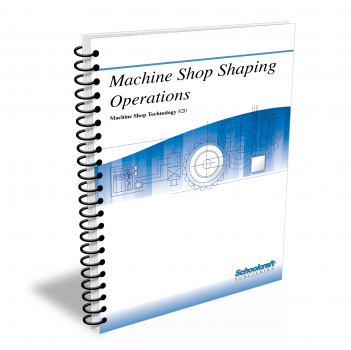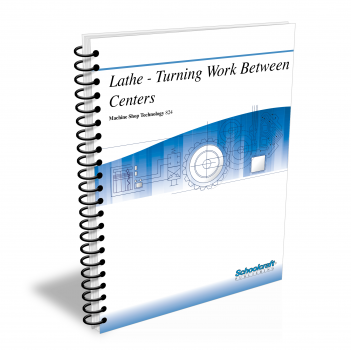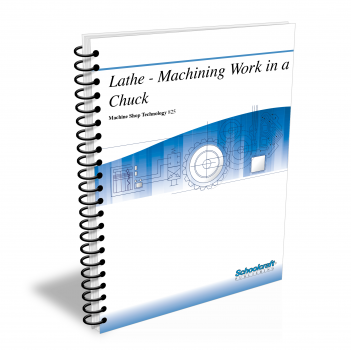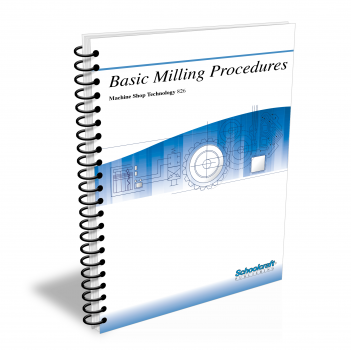Mechanical Installation
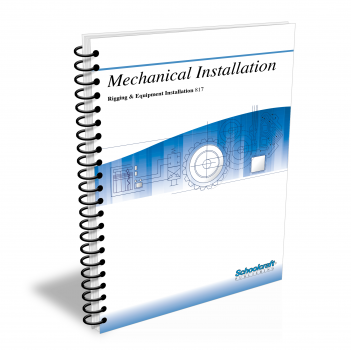
Course Number: 817
The Mechanical Installation textbook covers the fundamentals of rigging. It begins by discussing the tools and fasteners needed to secure rigging. It goes on to discuss the techniques and safeguards for ropes, chains, hoists, and scaffolding. The textbook concludes by examining procedures and factors affecting installation of large plant equipment.
Does your curriculum require additional topics not included in this textbook? Build a customized version of the mechanical Installation textbook below.
Recommended Contact Hours – 22
Preview a Chapter
Available Supporting Material
- Table of Contents
- My Custom Book
- Exam Copies
- Suggested Titles
Table of Contents
Chapter 1: Wrenches and Screwdrivers
Topics: Wrenches-open-end, box-end, combination, socket, adjustable, torque; Screwdrivers-standard, cross-slot, spiral, ratchet, offset; Driving and removing screws; Restoring a blade
Learning Objectives:
- Identify types of materials used for making wrenches.
- Identify open-end, box-end, socket, socket-head, adjustable, torque, and striking-face wrenches.
- Describe two sizes that are important in identifying a socket wrench.
- Identify standard, Phillips, offset, and spiral-ratchet screwdrivers.
- List the steps to follow when driving a screw.
Chapter 2: Fasteners
Topics: Threaded fasteners; Screw threads; Types of nuts; Washers; Safety wiring; Keys and pins; Rivets
Learning Objectives:
- Identify seven major types of threaded fasteners.
- Read and interpret common screw thread and threaded fastener specifications.
- Describe the three actions in a manual riveting operation, and explain why each action must be done properly.
- Demonstrate the proper technique for safety wiring a group of threaded fasteners.
- Identify three kinds of washers.
Chapter 3: Introduction to Industrial Rigging
Topics: Rigging tools; Determining weight and center of gravity; Vertical and horizontal force; Slings; Hooks; Hoist hooks; Special-purpose rigging hooks
Learning Objectives:
- Identify the tools used in rigging and explain the purpose of each.
- Give examples of three methods of calculating the weight of a load.
- Explain center of gravity and its importance in rigging a load.
- Describe four common sling arrangements and the relation between sling angle and horizontal force.
- Name five types of hooks frequently used in rigging and explain the purpose of each.
- Discuss proper hook use and cite four reasons for removing a hook from service.
Chapter 4: Wire Rope and Wire-Rope Slings
Topics: Wire rope construction, classification, and strength; Seizing, cutting, and splicing; Wire-rope slings; Inspection
Learning Objectives:
- Identify the component parts of wire rope and describe its construction and classification.
- Identify and discuss the factors that affect wire rope strength.
- Describe the basic single-leg and multiple-leg slings and the calculation of their allowable loads.
- Enumerate the signs of damage that would probably cause a wire rope to be removed from service.
Chapter 5: Chain and Metal-Mesh Slings
Topics: Welded-link chain; Chain grades and strength; Chain slings; Inspecting slings; Metal mesh slings; Sling materials
Learning Objectives:
- Identify the different grades of chain and name some of their applications.
- Define the terms working load limit, proof test, and minimum breaking force.
- List and discuss four factors that affect the strength of chain slings.
- Describe three types of damage you might see in a daily inspection of chain slings that would lead you to set the sling aside for more thorough examination.
- Describe the two standard types of end fittings for metal mesh slings and the hitches for which each can be used.
- Name several advantages of, and applications for, metal mesh slings.
- List the visible signs of damage that would cause you to recommend a sling's removal from service.
Chapter 6: Fiber Rope and Webbing Slings
Topics: Natural and synthetic-fiber rope; Sling strength; Whipping rope ends; Splicing fiber rope; Synthetic webbing; Inspecting slings
Learning Objectives:
- Identify the grades of manila rope that can be used for overhead lifting.
- Name the three commonly used synthetic-fiber ropes and list three of their advantages over manila.
- Discuss the factors that affect the strength of fiber rope.
- Name the signs of wear or damage that would warrant setting a fiber-rope sling aside for more detailed inspection.
- Describe an encased polyester fiber sling.
- Explain the construction of synthetic-web slings and name four of the basic types.
- List examples of visible damage that should cause a synthetic-web sling to be removed from service.
Chapter 7: Industrial Hoists and Cranes
Topics: Overhead manual chain, power, and wire-rope hoists; Side pull; Overload limit device; Underhung and top-running cranes; Jib cranes; Inspection
Learning Objectives:
- Describe the characteristics of the various kinds of overhead hoists.
- Explain the differences between single and double reeving.
- Explain the proper function and operation of an upper limit switch and an overload limit device.
- Describe and contrast the construction of top-running and underhung cranes.
- Identify the three basic types of jib cranes.
- Describe what the rigger's daily visual inspection should include.
- List examples, from the additional criteria given in this Lesson, of conditions that should warrant removal of wire rope or hoist load chain from service.
Chapter 8: Operating Practices
Topics: Hoist and crane operation; Special heavy lifts; Pulling, setting, and turning a load; Eyebolts; The thought process of rigging
Learning Objectives:
- Enumerate the general operating practices that apply to all tools of rigging.
- Explain the 11 operating practices that apply to slings.
- Discuss nine operating practices that should be observed when using a hoist or crane.
- Detail the special circumstances under which a hoist or crane may be used to pull a load or lift a load heavier than the equipment's rated capacity.
- Describe three methods of turning a load.
- Discuss the eight questions that a rigger must answer in the thought process that should precede any lift.
Chapter 9: Scaffolds and Ladders
Topics: Types of scaffolds; Guy lines; Accessories; Ladders; How to raise and inspect a ladder; Life belts; Scaffold and ladder safety
Learning Objectives:
- Explain the construction of pole and suspension scaffolds and lift platforms, and the safety measures that apply to them.
- Name several scaffolding accessories and explain their use.
- Discuss recommended usage and inspection of the three common types of ladders.
Chapter 10: Building Drawings
Topics: Buildings and building sites; Symbols and conventions; Plat, site, and floor plans; Working drawings
Learning Objectives:
- Name building materials, given their standard symbols.
- Explain how to find useful information on a flow diagram.
- Explain how to find useful information on an industrial plat.
- List the contents of a set of building drawings.
- Describe the purpose of a structural drawing.
Chapter 11: Preparing the Site
Topics: Relocating underground piping, wiring, and cables; Barricading the work area; Removing excavated materials; Foundations and footings; Reinforced concrete; Safety precautions for excavating
Learning Objectives:
- Tell who plans the installation of new equipment and list the steps involved.
- Define the terms foundation and footing.
- Tell which type of ground will support the most weight.
- Explain how steel rods are held in position when pouring a concrete footing.
- Name the best materials for filling around a foundation.
- Explain how to protect concrete that might come into contact with oil or chemicals.
- Tell how long new concrete must sit before equipment is installed on it.
Chapter 12: Vibration Control and Anchoring
Topics: Selecting anchors and isolators; Isolator mounts; Anchor bolts; Using power hammers; Grouting
Learning Objectives:
- Define vibration and tell how it enters and leaves equipment.
- Tell what type of isolation is best to use on sensitive testing instruments.
- Explain how to isolate anchor bolts when mounting equipment on pads.
- Tell what type of wrench to use for tightening anchor bolts.
- Name the best tool for drilling anchor bolt holes in concrete.
- Tell why the bases of production and processing equipment should be grouted.
- Explain why you must not use a concrete mix to grout anchor bolts.
Chapter 13: Moving and Setting
Topics: Uncrating; Relocating; Lifting; Raising with jacks and slings; Crowbars; Making the move; Personal safety
Learning Objectives:
- Explain the procedures involved in relocating existing equipment.
- Tell two things you must know before lifting equipment with a hoist.
- List three things to consider when selecting a jack.
- Explain the operation and uses of a roller skid.
- Tell where to find a floor's allowable load.
Chapter 14: Leveling and Aligning
Topics: Leveling devices; Wedges and shims; Checking alignment; Aligning equipment on the foundation; Alignment screws; Aligning machine tools
Learning Objectives:
- Explain the correct way to handle a master precision level.
- Explain how to check the accuracy of a level.
- Name the greatest enemy of precision tools.
- Explain how to level V-shaped ways.
- Tell which leveling device is used most often on small equipment.
- Name three tools commonly used to check alignment.
- Tell how to set an alignment screw to prevent its movement.
Chapter 15: Checking and Test Running
Topics: Electric, hydraulic, and pneumatic connections; Coolant systems; Safety devices; Settings and adjustments; Making the test run; Safety
Learning Objectives:
- Explain how to test for the presence of moisture in electrical equipment.
- Tell what device is commonly used to prevent excessive pressure in a hot water heater.
- Explain the function of a pressure regulating valve.
- List the steps to take before initial equipment startup.
- Tell the usual cause of excessive temperature during equipment startup.
Add Chapters to Your Custom Book
Select Chapter(s):
- Chapter 1: Wrenches and Screwdrivers
- Chapter 2: Fasteners
- Chapter 3: Introduction to Industrial Rigging
- Chapter 4: Wire Rope and Wire-Rope Slings
- Chapter 5: Chain and Metal-Mesh Slings
- Chapter 6: Fiber Rope and Webbing Slings
- Chapter 7: Industrial Hoists and Cranes
- Chapter 8: Operating Practices
- Chapter 9: Scaffolds and Ladders
- Chapter 10: Building Drawings
- Chapter 11: Preparing the Site
- Chapter 12: Vibration Control and Anchoring
- Chapter 13: Moving and Setting
- Chapter 14: Leveling and Aligning
- Chapter 15: Checking and Test Running
My Custom Book
Create a custom book that contains only the training content that your students need to succeed
Our topics cover a broad and diverse spectrum of subject matter, from reading blueprints to electrical schematics, measurement to rigging and safety, material handling to welding, and everything in between! Choose only the lessons that meet your specific curriculum requirements.
Request Exam Copies
Exam Copies
Ready to see a copy of our textbooks? After selecting which textbooks you’d like to review for your course, you can submit your request by either logging in or creating an account so we know where to ship your exam copies. A representative from Schoolcraft will contact you to confirm and finish processing your request.
Exam copies are always free and yours to keep.
Selected Exam Copies
none selected
* Maximum of five copies can be ordered
